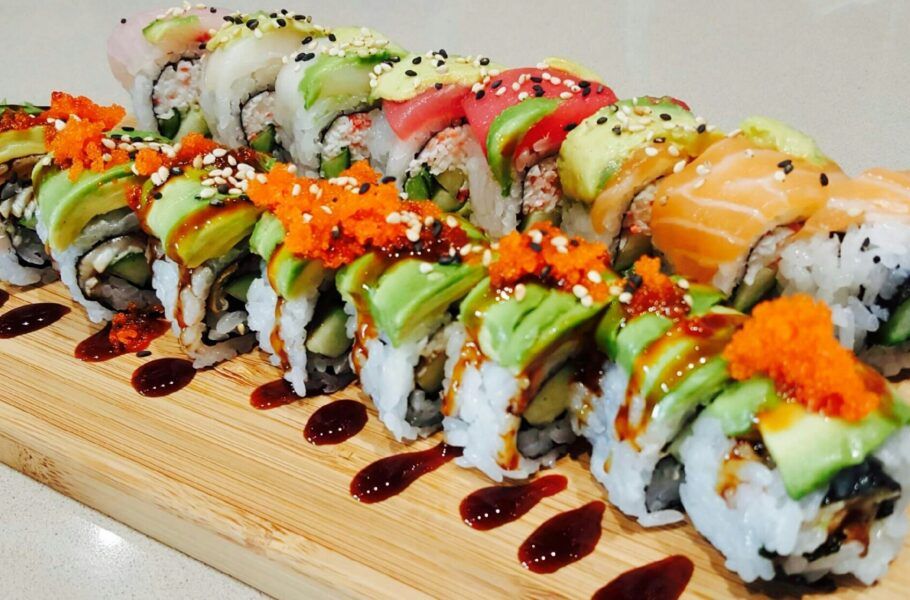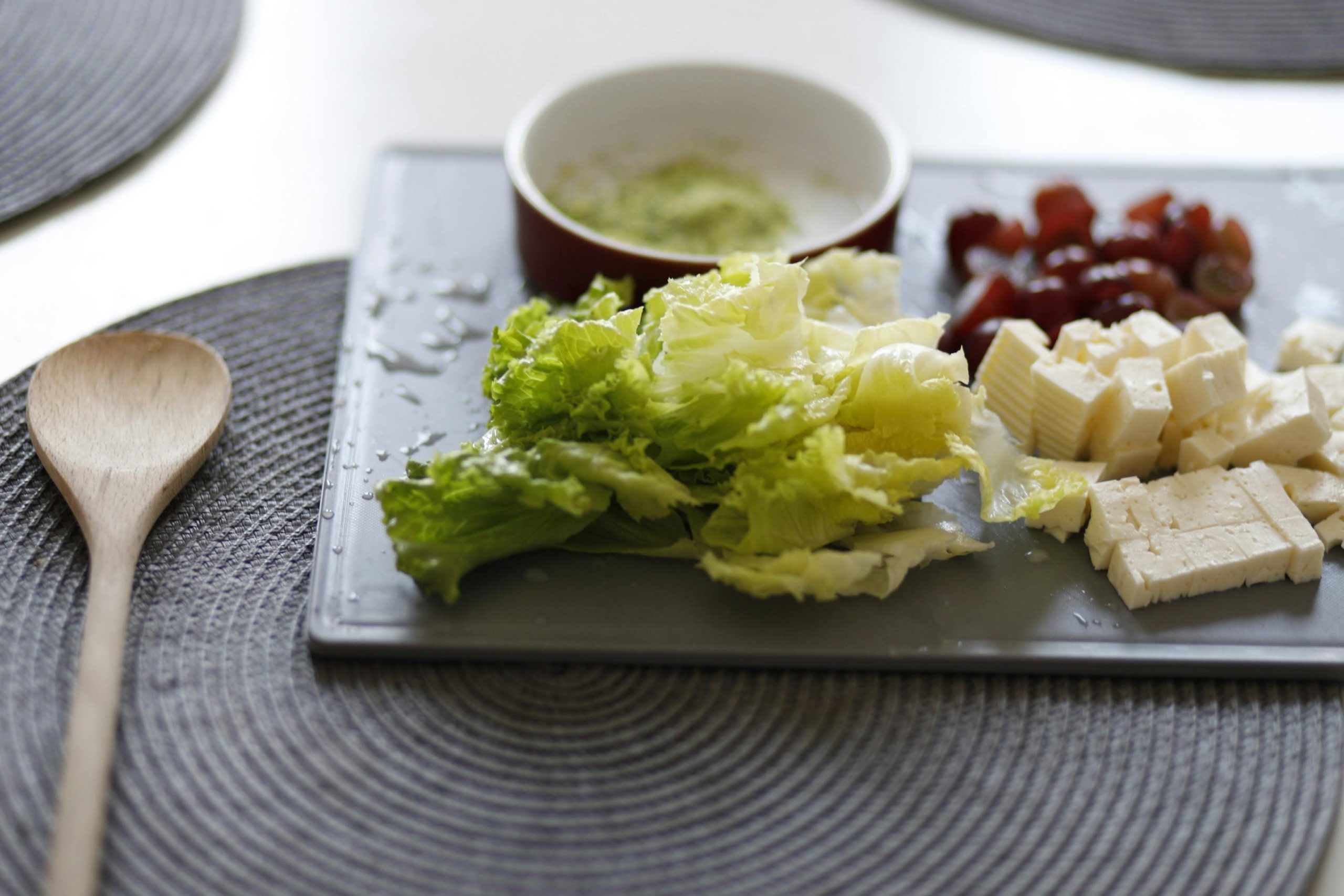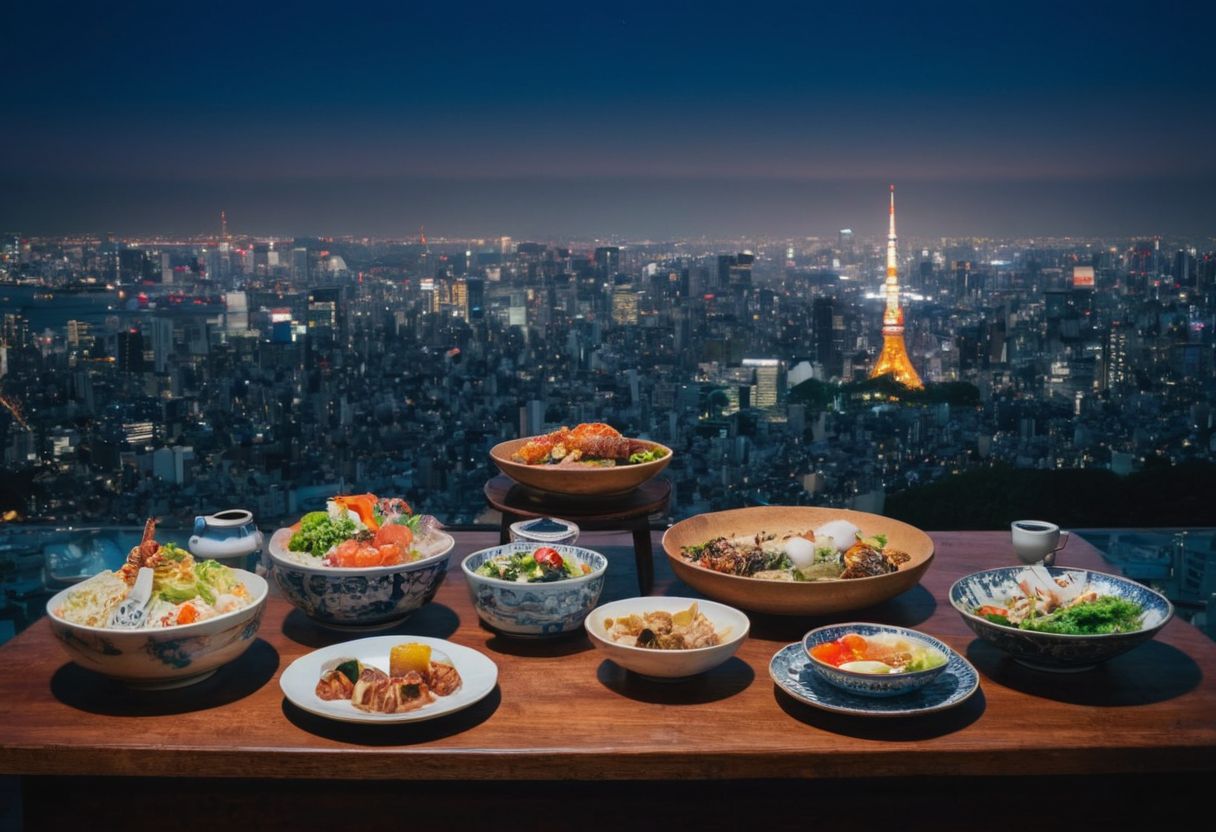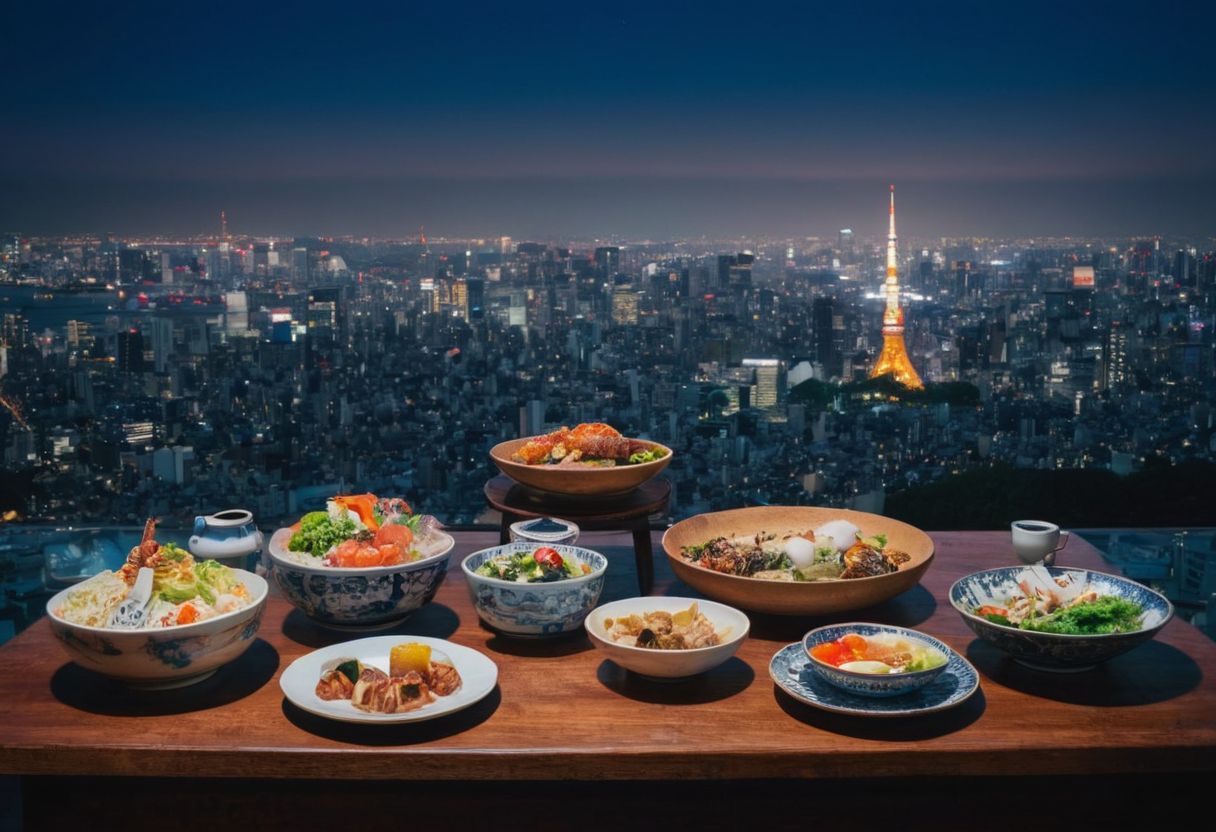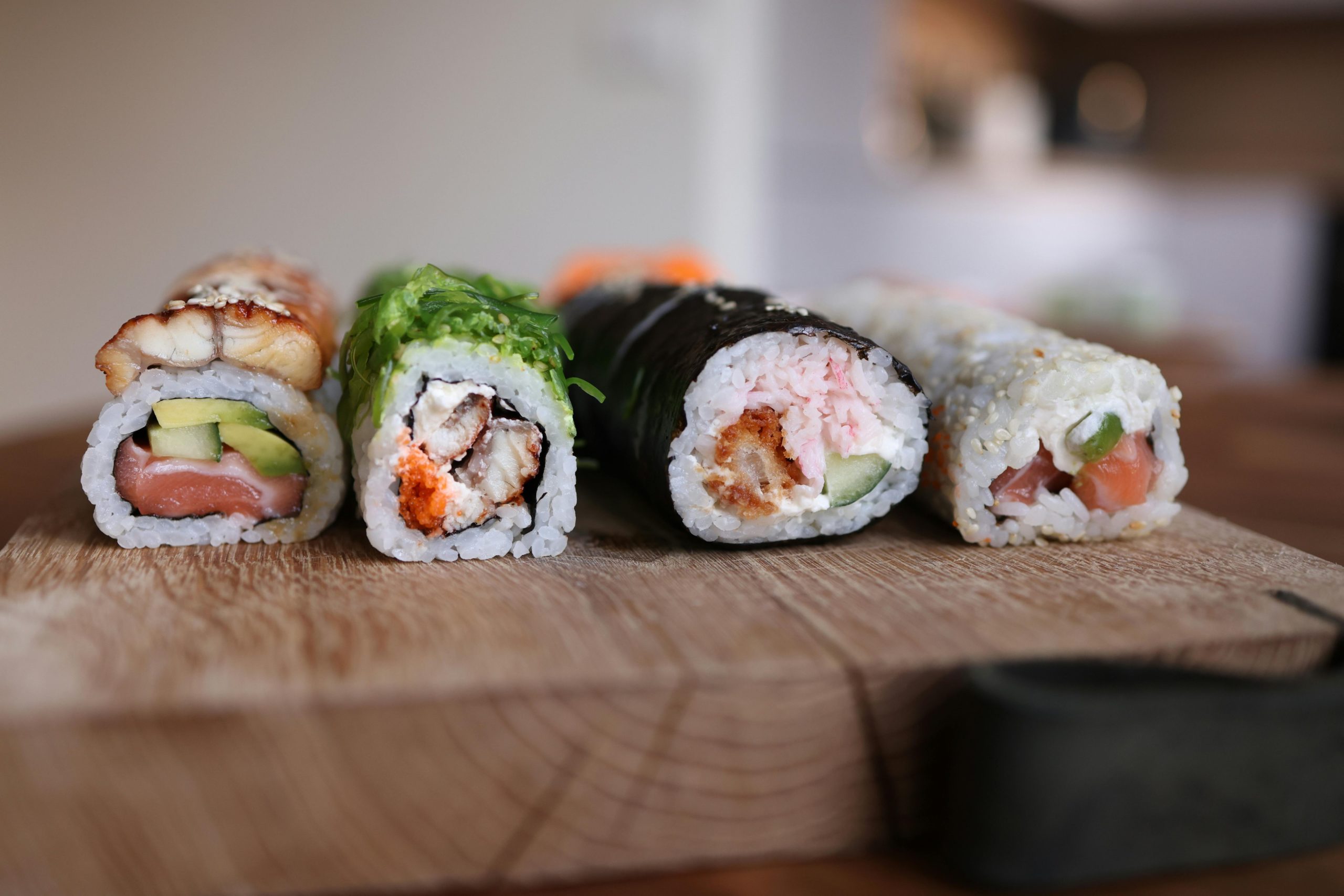Have you ever wondered what makes sushi in Japan so distinctively delicious and globally celebrated?
For many, navigating the vast world of sushi can be as intimidating as it is intriguing, especially when trying to distinguish authentic practices from common misconceptions.
Sushi, a traditional Japanese dish, is not just about raw fish; it’s an art form that combines vinegared rice with various toppings like seafood, vegetables, and sometimes even fruits.
In this comprehensive guide, we’ll delve into the historical evolution of sushi, explore its diverse forms, and master the art of sushi preparation, while debunking popular myths and guiding you through the proper ways to enjoy this exquisite cuisine in Japan.
The Historical Evolution of Japan Sushi

The journey of sushi from a primitive method of fish preservation to a sophisticated culinary art form is a fascinating aspect of Japanese culture. Originally, during the 3rd century BC, sushi began as a necessity, a way to preserve fish using fermented rice. This method, known as narezushi, was discovered in Southeast Asia and eventually made its way to Japan. The rice was initially used to ferment the fish and was discarded before consumption, focusing solely on the preserved fish.
Over the centuries, sushi underwent significant transformations, particularly during the Edo period in the 17th century. It was during this time that sushi started to resemble what we know today. Matsumoto Yoshiichi in Edo innovated by seasoning the rice with vinegar, which not only enhanced the flavour but also reduced the preparation time significantly. This marked the transition from preserved to freshly made sushi, which could be prepared and eaten instantly, laying the foundation for contemporary sushi.
By the 19th century, with the advent of the Hansei period, sushi evolved rapidly, adapting to the faster pace of life in Tokyo. The introduction of nigirizushi, which is hand-pressed sushi, by chef Hanaya Yohei, revolutionized the sushi scene. This style allowed for quicker preparation and consumption, aligning perfectly with the bustling street life of Tokyo. These historical shifts highlight how sushi reflected not only culinary preferences but also social and economic changes in Japan.
Exploring the Diverse Forms of Sushi Japanese Food

Sushi in Japan is celebrated for its variety and regional specialities, each with unique preparation methods and ingredients. The most common types include nigiri, a simple yet elegant type of sushi consisting of a slice of raw fish over pressed vinegared rice; sashimi, which, strictly speaking, isn’t sushi since it doesn’t include rice but is often associated with sushi due to its presence in sushi bars; and maki, the seaweed-wrapped rolls filled with rice, fish, and vegetables.
Other less known but equally traditional forms include temari, small, ball-shaped sushi that is often colourfully decorated, and chirashi, a bowl of vinegared rice topped with a variety of fish and seafood. Each type offers a different experience in taste and texture, showcasing the versatility and broad appeal of sushi. These varieties not only provide a delightful taste experience but also a glimpse into the regional diversities of Japan.
Mastering the Art of Sushi Preparation

Mastering sushi preparation is an art that demands precision and patience, particularly in the traditional Japanese context. The process begins with selecting the right kind of fish, focusing on freshness and quality. Sushi-grade fish is essential, as it ensures safety and flavour. The preparation of sushi rice, or shari, is also crucial; it must be seasoned with just the right amount of vinegar, sugar, and salt to achieve the perfect balance of sweetness and tanginess.
The assembly of sushi, whether it’s rolling maki or crafting nigiri, requires meticulous hand skills that are often honed over years of training. For example, nigiri must be shaped so that the rice is airy yet compact, providing the ideal base for the fish. Techniques vary by type, but the principles of cleanliness, precision, and respect for ingredients remain constant, reflecting the deep cultural reverence for nature and craftsmanship in Japanese cuisine.
Debunking Myths About Sushi Food
A common misconception about sushi is that it always involves raw fish. In reality, sushi refers to the seasoned rice and can include a variety of toppings and fillings, including cooked ingredients. Sashimi is the term for thin slices of raw fish and is distinct from sushi, although often served at sushi restaurants. This distinction is crucial for appreciating the diverse offerings of traditional Japanese sushi.
Another myth is that sushi is inherently a low-calorie food. While it can be part of a healthy diet, the caloric content of sushi varies widely depending on the ingredients used. Rolls with deep-fried ingredients or creamy sauces can be higher in calories. Understanding these nuances can enhance one’s appreciation of sushi and enable more informed choices when dining.
The Crucial Role of Rice in Authentic Japanese Sushi
Rice isn’t just a side dish in Japanese sushi; it’s the foundation that holds the art of sushi together. The type of rice used in sushi, commonly referred to as shari, is typically a variety of short-grain rice known as Japanese short-grain rice. This rice is prized for its ability to stick together, which is essential for forming well-structured sushi. The preparation of sushi rice involves a meticulous process where the rice is washed, cooked, and then seasoned with a mix of vinegar, sugar, and salt. This combination not only flavours the rice but also gives it a glossy sheen and a sticky consistency that is perfect for sushi.
The quality and preparation of sushi rice have a profound impact on the taste and texture of sushi. Perfect sushi rice should be slightly warm with a soft yet firm texture that complements the freshness of the fish. It should not be mushy or overly sticky. The subtle tang of the vinegar helps to enhance the flavours of the fish, making each bite a harmonious blend of tastes and textures. In high-end sushi restaurants, the preparation of sushi rice is considered an art form, with chefs spending years perfecting their technique. The rice must be cooled to body temperature before being paired with the topping or neta, which is crucial for achieving the perfect balance in sushi.
The Proper Way to Enjoy Real Japanese Sushi

Enjoying sushi in Japan is an experience that extends beyond taste—it’s a cultural ritual that involves specific etiquettes. Firstly, when eating nigiri (sushi with a topping of fish or seafood on top of vinegared rice), it is customary to turn the sushi upside down when dipping it in soy sauce to avoid soaking the rice, which can cause it to fall apart. Using your hands to eat nigiri sushi is also traditional, reflecting the origins of sushi as a quick snack. For sashimi, which is just slices of raw fish, chopsticks should be used. Additionally, it’s important not to mix wasabi directly into the soy sauce, as the sushi chef has already placed the ideal amount of wasabi on the fish to achieve the perfect balance of flavours.
The order in which sushi is consumed also plays a significant role in the dining experience. Start with lighter, more delicate flavours, such as white fish, and progress to richer, fattier types like tuna. This allows one to appreciate the subtle differences in flavour and texture. Between different sushi pieces, it’s customary to eat a small piece of gari (pickled ginger), which acts as a palate cleanser, preparing the mouth for the next type of sushi. Remember, sushi is not just food; it’s an art form where every element, from the preparation of the rice to the way it’s consumed, is steeped in tradition and respect for the ingredients.
Discovering Japan’s Top Sushi Restaurants
Japan is renowned for its sushi, offering an array of experiences from high-end Michelin-starred restaurants to more casual conveyor belt sushi bars. In Tokyo, the heart of sushi innovation, visitors can explore establishments like Sukiyabashi Jiro, where the focus is on the sublime quality of sushi, despite the modest surroundings. These upscale experiences often come with a hefty price tag but promise an unforgettable gastronomic journey, meticulously crafted by seasoned sushi chefs.
For those looking for a more relaxed atmosphere without sacrificing quality, conveyor belt sushi restaurants offer a fun and interactive dining experience. Places like Sushi no Midori serve up fresh, quality sushi at a fraction of the cost of high-end restaurants. These spots are perfect for diners who prefer a variety of sushi options and a less formal setting. Here, guests can enjoy watching their chosen dishes arrive via conveyor belts, adding a unique visual element to the dining experience.
Regardless of where you dine, the quality of sushi in Japan is largely unparalleled, owing to the country’s access to some of the freshest and finest seafood in the world. Whether it’s a luxurious omakase meal or a quick bite at a local kaitenzushi spot, each provides a distinct taste of Japanese culture and culinary expertise. This diversity in dining options ensures that every sushi lover, regardless of budget, can find something to savour in Japan.
Elevate Your Culinary Journey with Authentic Sushi Insights
Learning about authentic sushi is more than just understanding different types of sushi; it’s about immersing oneself in a deep cultural tradition that enhances any culinary journey. For those eager to elevate their gastronomic adventures, gaining insights into traditional sushi preparation and etiquette can transform a simple meal into a profound experience. This knowledge not only enriches the palate but also deepens appreciation for the culinary arts, making each dining experience more meaningful. INDULGE offers curated culinary tours that include such educational elements, ensuring that participants not only taste but also understand the cultural significance of the dishes they enjoy.
By integrating authentic sushi insights into its culinary tours, INDULGE provides an unparalleled opportunity to explore this exquisite cuisine. Participants of these tours can expect:
- A deep dive into the history and preparation techniques of sushi,
- An understanding of the proper ways to enjoy sushi, enhancing the overall dining experience,
- Exclusive insights into pairing sushi with appropriate drinks and accompaniments. Whether you’re a seasoned foodie or a curious tourist, these tours promise a comprehensive introduction to both local and international culinary traditions, making every bite a learning opportunity and a delight.
Frequently Asked Questions
What is traditional Japanese sushi?
Traditional Japanese sushi is an art form that combines vinegared rice with various toppings like seafood, vegetables, and sometimes fruits. It includes diverse forms such as nigiri, sashimi, maki, temari, and chirashi, each offering unique tastes and experiences. The preparation of sushi involves meticulous techniques, focusing on the freshness and quality of ingredients, especially the sushi-grade fish and perfectly seasoned sushi rice.
What is Japan known for sushi?
Japan is renowned for its exceptional quality and variety of sushi, ranging from high-end Michelin-starred restaurants to casual conveyor belt sushi bars. The country’s access to fresh and fine seafood significantly contributes to the unparalleled quality of sushi. Japan offers a wide range of sushi dining experiences, catering to all budgets and preferences, making it a central aspect of Japanese culinary culture.
What is sushi called in Japan?
In Japan, sushi refers to the seasoned rice combined with various toppings and is broadly categorized into types like nigiri, maki, and sashimi. The term “sushi” itself is used in Japan to describe this dish.
What are sushi places called in Japan?
Sushi places in Japan are often referred to as sushi restaurants or sushi bars. High-end dining spots may be known as omakase restaurants, where chefs serve specially selected meals to guests. More casual settings include conveyor belt sushi restaurants, locally known as kaitenzushi, which offer a fun and interactive dining experience.

